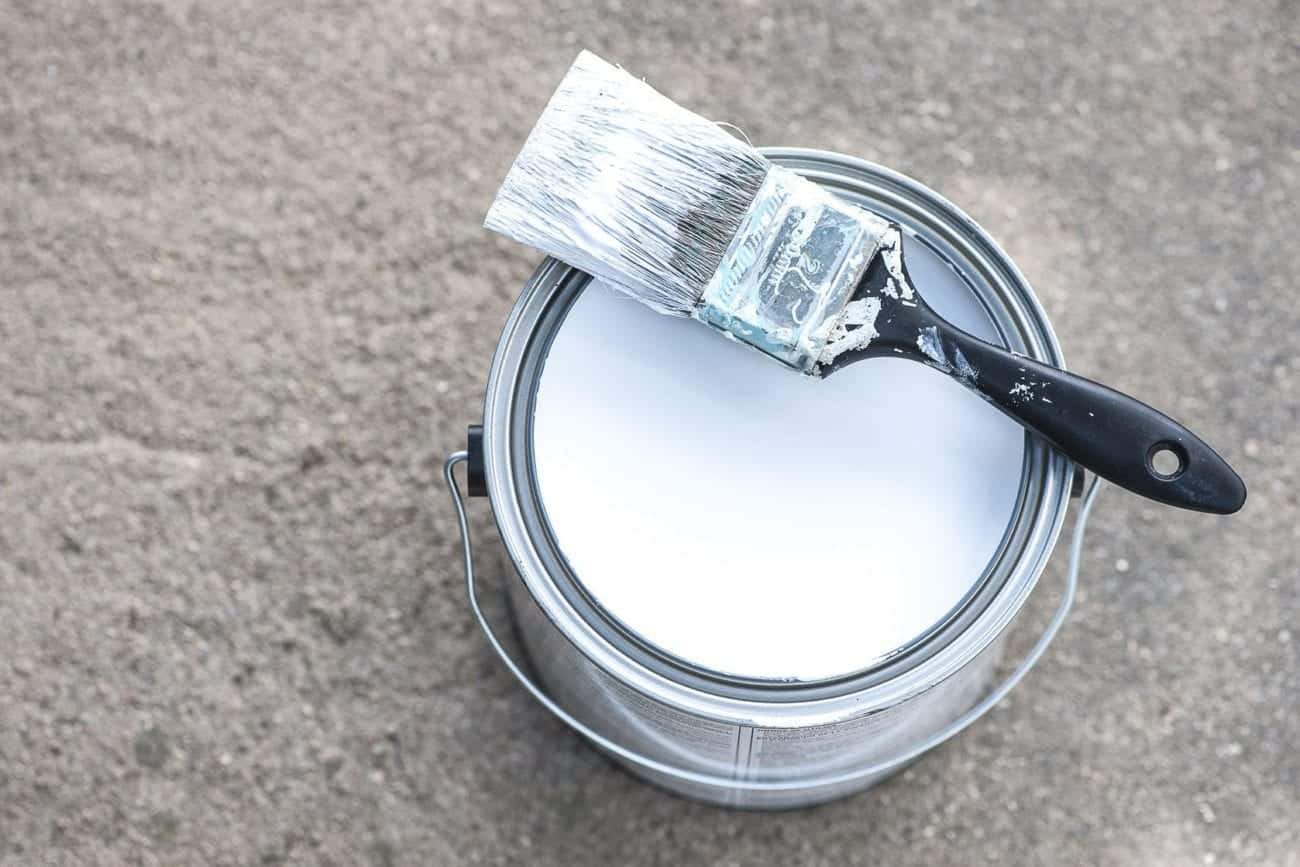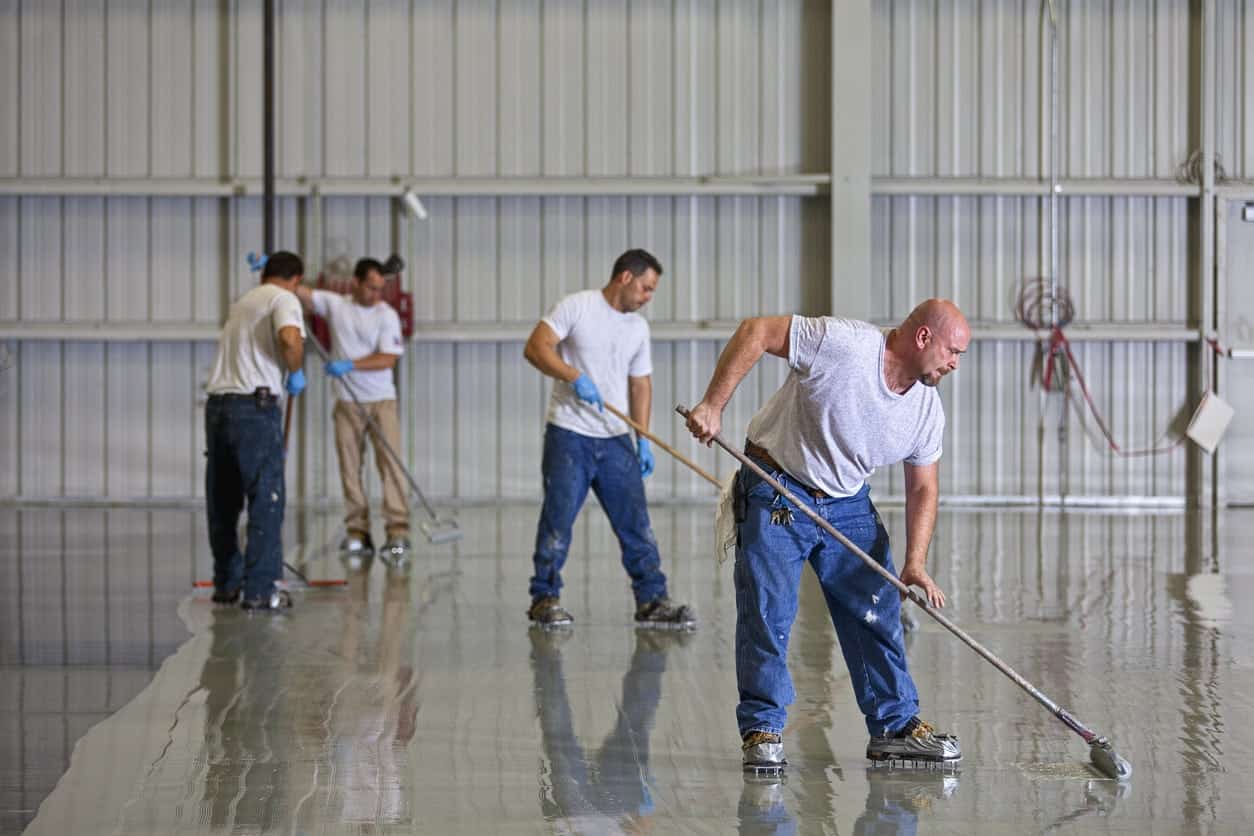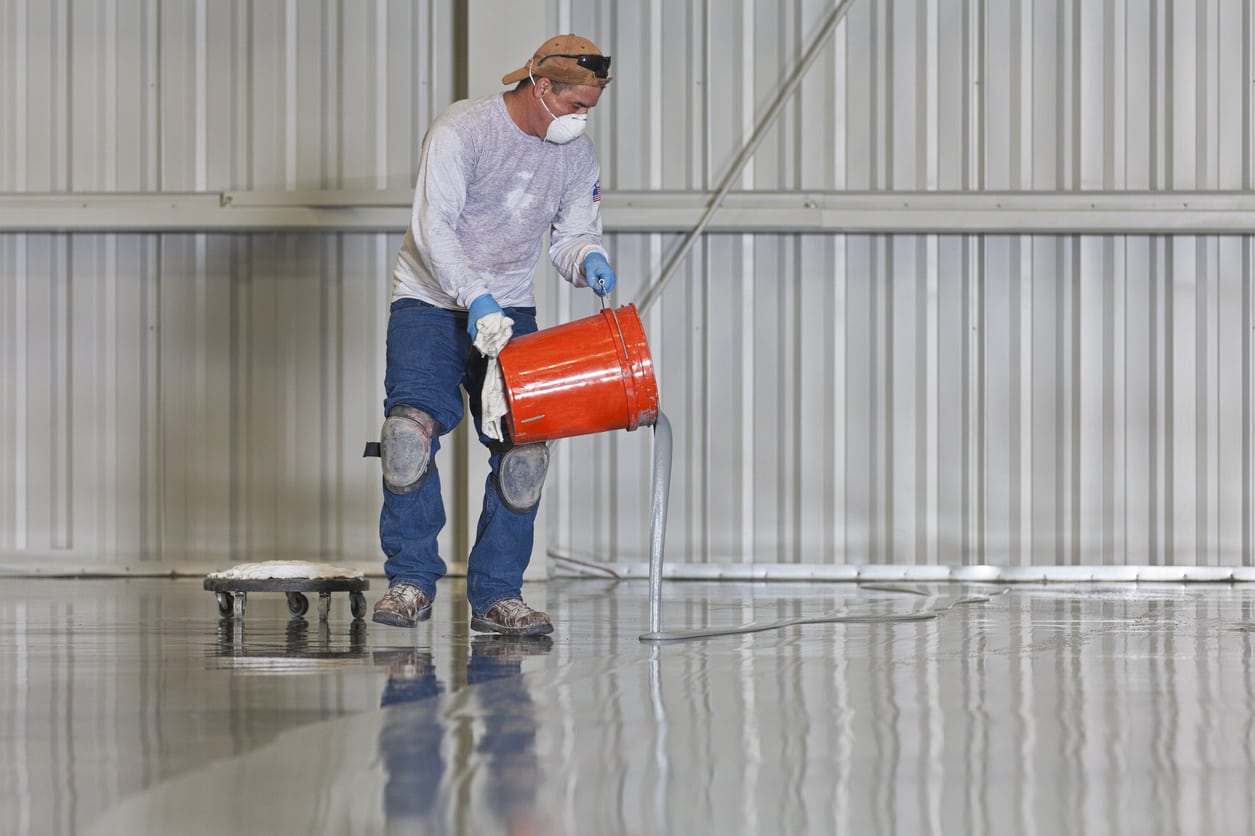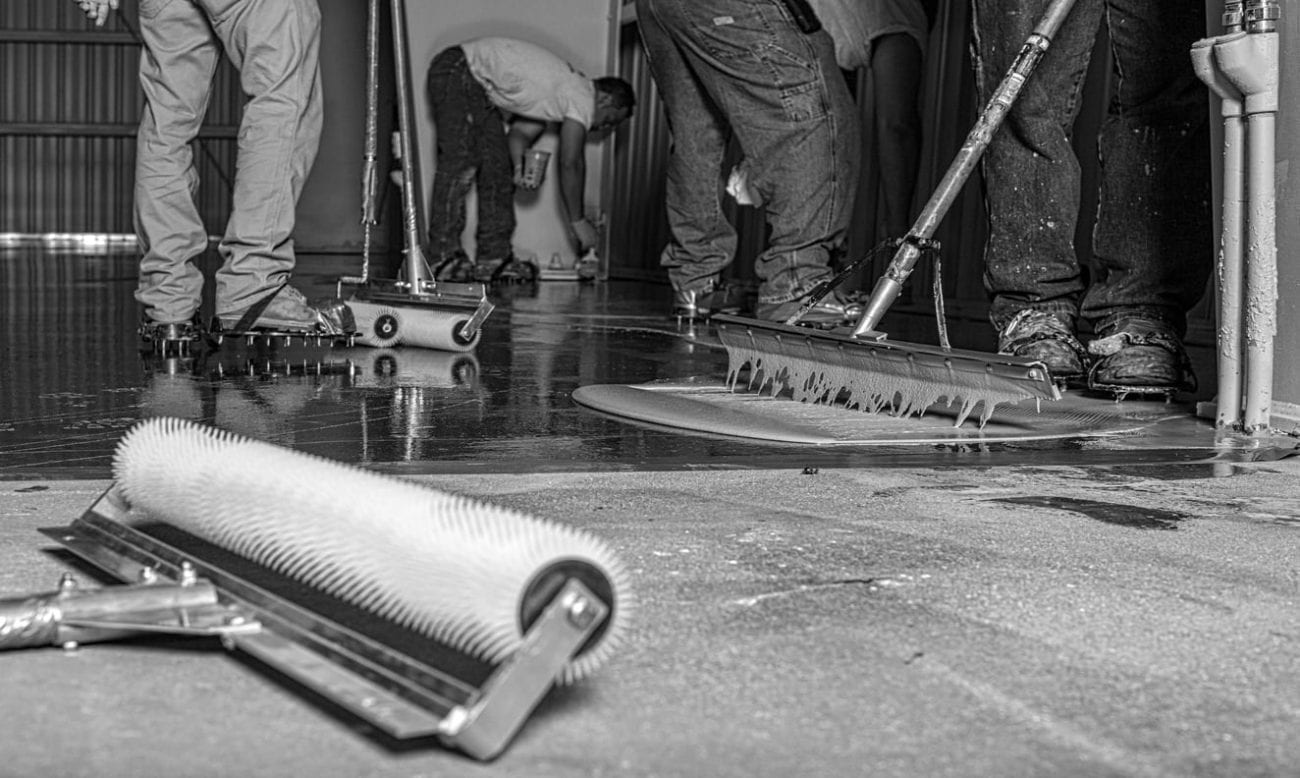Silicates: Penetrating sealers, usually densifiers, that chemically react with the concrete forming calcium silicate hydrate to fill in all voids, pores and tracts. Sodium , lithium and potassium are the most popular carriers of silicate. Best sealers for densifying, dust-proofing and hardening concrete. Indefinite protection.
SIlicate/Siliconates: Blended sealers that encompass all of the densifying benefits of a silicate with the waterproofing characteristics of a siliconate sealer. The siliconate molecules react at the surface with the carbon dioxide in the air forming a hydrophobic barrier. Sodium, lithium and potassium are the most common carriers of silicate/siliconates. Best sealers for densifying, dust-proofing, hardening and waterproofing concrete. Indefinite protection.
Silane/Siloxanes: Blended sealers that also form a hydrophobic barrier on the surface of the concrete that offer excellent water repellency. A water beading effect is a result of this type of sealer. Best sealers for sealing and protecting concrete blocks, cinderblocks, stucco and very porous concrete. 10 years of protection before needing another application
Acrylics: Topical sealers usually water based or solvent based (low sheen and high gloss respectively) that seal concrete and repel water. Most commonly used as decorative sealers on concrete, stone, brick and masonry. Acrylics need to be reapplied quite frequently. 1-5 years of protection before needing another application.
Epoxies/Urethanes/Polyaspartics: Durable coatings that are usually applied in conjunction as part of an epoxy system. Usually consisting of a base coat, build coat and top coat with or with out decorative sand or paint chips. Excellent chemical resistance, UV and abrasion resistance properties. The toughest grade of sealers lasting about 10 years before needing another application.
Aliphatic urethanes are similar to epoxy sealers. They are both surface level concrete sealers that feature large particles of sealant that, rather than penetrate past the tiny surface pores natural to all concrete, will remain on the surface of the concrete to be spread out evenly during the application process. Once so spread out, the aliphatic urethane (like the epoxy sealer) will feature a strong adhesive bond to the concrete substrate, protecting the concrete underneath from abrasion, heat, water, chemical spills, and similar threats.
However, aliphatic urethanes are significantly stronger than epoxies, featuring a greater level of resistance to the aforementioned threats. This makes aliphatic urethanes the preferred choice for industrial warehouses that feature heavy machinery and frequent chemical spills, as well as airports and large retail stores that have heavy foot traffic and frequent spills. Aliphatic urethanes and epoxy concrete sealers do not actually have to be mutually exclusive products, either. In fact, many people frequently choose to apply an epoxy base layer to the concrete substrate before adding a layer of aliphatic urethane over that epoxy layer. The aliphatic urethane will actually bond just as well to the pre-existing epoxy as it will to the concrete itself, making it the perfect choice for a topcoat.
Of course, aliphatic urethanes are not the perfect choice for every type of concrete project. Sometimes you will need a penetrating sealer, like a concrete densifier, to achieve the desired results. Concrete densifiers are different from aliphatic urethanes primarily because they feature small particles of sealant that will penetrate past the surface pores natural to all concrete, passing through the extensive network of microscopic pores and hairline cracks to react chemically within the concrete. These chemical reactions actually enhance the very nature of the concrete, greatly increasing its strength, longevity, and structural integrity.
Concrete densifiers are preferred to aliphatic urethanes for smaller projects, such as for homes or buildings, rather than large retail stores, airports, or warehouses. They are often waterproofers (if you find a silicate/siliconate variety), and some even create vapor barriers that make them the most effective type of concrete sealer against potential water damage. They feature many of the same benefits as aliphatic urethanes, though they are not as strong and will not withstand as harsh of conditions.
Our Take: Some excellent aliphatic urethane choices we recommend are Superior Industries Aliphatic Urethane or Urethane 645. As far as concrete densifiers we recommend Lion Hard, Lithi-Tek 4500 and Formula One
Garage floors are one of the most high traffic areas of most homes. Not only do they feature the constant foot traffic of those entering and leaving the house, they also need to withstand the weight and abrasion of tires, as well as the chemical spills from oil and other acidic materials. This is not to mention the harm of the freeze/thaw cycle if water gets into the concrete, in addition to the oversaturation of sodium if you track road salts into your garage. In short, they require a significant level of strength and protection, or else they will likely crack and degrade, leading to costly repairs.
There are two main solutions to this problem, and they both involve treating the concrete with a high quality concrete sealer. The first is to use an epoxy sealer. Epoxies are surface level sealers whose large particles of chemical sealant cannot penetrate past the tiny surface pores natural to all concrete. The epoxy will pool of the surface of the concrete to be spread out evenly during the application process. As a result of this process, the epoxy will bond to the surface of the concrete substrate, leading to comprehensive protection from heat, water, chemical spills, abrasions, and so on. Epoxies are an excellent choice, especially if you want to add some visual appeal in the form of paint chips or decorative quartz to your concrete.
Epoxies, however, will change the surface texture of your concrete from that of natural concrete to a smoother surface, similar to what you would find in an airport or large retail store. If you happen to prefer a natural concrete garage floor, you should choose the second main solution, concrete densifiers. Concrete densifiers are also necessary if you want to polish your garage floor – be sure to apply one before the polishing or grinding process begins, as that would be too late, leading to widespread crumbling.
Concrete densifiers work by penetrating past the surface of the concrete to chemically react with the naturally occurring minerals and compounds to create more calcium silicate hydrate, or CSH, which is the compound that gives concrete its noted strength. Concrete densifiers come in two main varieties: sodium-based and lithium-based. For garage floors, we always recommend lithium-based concrete densifiers, as they are better when your car tracks in salt from the roads. Sodium-based concrete densifiers will lead to an oversaturation of sodium in your concrete, while the lithium concrete densifiers will help retain the balance of salts and chemicals necessary to preserve strength and longevity.
When searching for a concrete sealer online, you can often be overwhelmed by the sheer amount of possible choices available to you. To make matters worse, companies, manufacturers, and distributors often do not explain which situations and types of concrete their sealers are appropriate for. For instance, if you do not do enough independent research, you could easily purchase an acrylic sealer without realizing that it is the wrong choice for a concrete basement floor – the manufacturer and/or the distributor will not give you this information, instead marketing their product in general terms designed to encourage the consumer to purchase their product.
There are two main varieties of concrete sealer types. The first are the penetrating sealers. These tend to be sodium silicates, lithium silicates, or lithium silicate/siliconates that are designed to penetrate past the surface pores natural to all concrete. Their small particles of sealant can seep through the microscopic holes dotting the surface of the concrete, which allows the sealant to enter the vast network of hairline cracks and microscopic pores that extend throughout the concrete. Once inside the concrete, these sealant particles react chemically with minerals already present in the slab, leading to the creation of more calcium silicate hydrate (or CSH), which is the naturally occurring mineral in concrete that gives it its strength. Because these types of sealers increase the concrete’s strength for life, they are often referred to as concrete densifiers – not only do they densify, they also block the passage of water, salts, and other potential harms through the concrete.
The other broad category of concrete sealer is the surface sealer. These topical level sealers contain large particles of sealant that cannot fit past the surface pores of the concrete. Instead, the solutions pool on the surface of the concrete to be spread out evenly during application. These products range from acrylic sealers to epoxies, urethanes, and polyaspartics, all of which are extremely different. However, they all bond to the surface of the concrete to lock out water and minerals from entering the material, much like a raincoat locks out water while you’re wearing it. For a more in-depth discussion about the various products mentioned here, please refer to other our other articles that we constantly update and add to for your convenience.
Urethanes and polyaspartics are topcoating concrete sealers that are specially designed to adhere and bond to the surface of concrete slabs. Once properly applied to the surface, the sealers offer incredible levels of protection, leading to them often being referred to as the miracle concrete sealers. They both offer extensive heat resistance, comprehensive scratch resistance, resistance to abrasions and high foot traffic, as well as prevention of acid and chemical stains.
Due to their plethora of preventative and protective properties, urethanes and polyaspartics are typically in high demand for industrial warehouses and large retail stores, namely places that feature high levels of foot traffic or potentially damaging activity (such as lifting bales of product or driving with a forklift over the concrete). Urethanes and polyaspartics work to protect the concrete underneath from any and all types of damage.
They also, however, work best as part of epoxy floor systems. Epoxy floor systems are typically layers of concrete sealer that are applied one after another to increase the protection offered to your concrete floors. Most systems consist of an epoxy basecoat that is meant to adhere directly on the concrete substrate’s surface, followed by another epoxy coating to increase resistance to various problems. Now, after the first two epoxy coatings, many people choose to install a decorative, aesthetic piece by sprinkling in paint chips or decorative quartz (which is really just sand) onto the second epoxy coating. With this completed, the urethane or polyaspartic topcoat is applied to provide maximum, translucent protection.
The biggest, and really only, difference between urethanes and polyaspartics is a big one. Polyaspartics tend to be slightly more expensive because they have an exceptionally fast dry-time. No, really, it is quite exceptional. Polyaspartics tend to be the topcoating of choice for large retail stores that need to be open the next day: simply apply the polyaspartic coating overnight, and it will be completely dry in only a few hours. When compared to urethanes, the benefits and coverage are the same, by the dry-time is exceptionally different.
Our Take: The best urethane we have found is an aliphatic urethane Urethane 645 while a fast drying polyaspartic is Polyaspartic 745.
- 1
- 2






